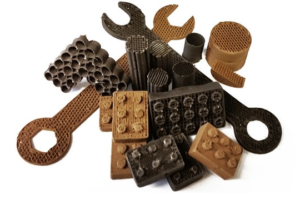Scientists use Martian dust to 3D print tools
Food and transportation aren’t the only aspects of a mission to Mars scientists must consider. Limited cargo space means to obtain tools or similar items, astronauts may need to make use of resources available on the red planet – like dirt. Four Northwestern University researchers were recently able to utilize a Martian dust simulant to 3D print building blocks and tools.
NASA started looking into space 3D printers back in 2013 to manufacture repair parts or tools. Now Northwestern scientists have used lunar and Martian dust simulants approved by NASA to 3D print tools in a process the university described as simple, scalable, and sustainable.
 The researchers drew on a technique they call a 3D-painting process; engineer Ramille Shah said using 3D paints “really open up the ability to print different functional or structural objects to make habitats beyond Earth.” They’ve created a 3D ink and printing method they’ve used to print 3D graphene and hyperelastic “bone.” They made their 3D paints for this project with simple solvents, biopolymer, and the dusts, which are similar to real Martian and lunar dust in terms of composition and particle size and shape. The structures they printed are more than 90 percent dust by weight.
The researchers drew on a technique they call a 3D-painting process; engineer Ramille Shah said using 3D paints “really open up the ability to print different functional or structural objects to make habitats beyond Earth.” They’ve created a 3D ink and printing method they’ve used to print 3D graphene and hyperelastic “bone.” They made their 3D paints for this project with simple solvents, biopolymer, and the dusts, which are similar to real Martian and lunar dust in terms of composition and particle size and shape. The structures they printed are more than 90 percent dust by weight.
The 3D-printed material is flexible, tough, and elastic, kind of like rubber. It can be shaped, folded, cut, or rolled. In addition to tools the team 3D-printed interlocking bricks Shah said are like LEGOS. According to Northwestern, “…this work highlights the potential to use a single 3D printer on another planet to create structures from all kinds of materials.”
The journal Nature Scientific Reports published the research online in late March. Shah and another Northwestern professor, who was not a co-author on this paper, are working together on ways to fire the 3D-painted objects in a furnace to make them harder – more like ceramic.
Source: http://inhabitat.com










